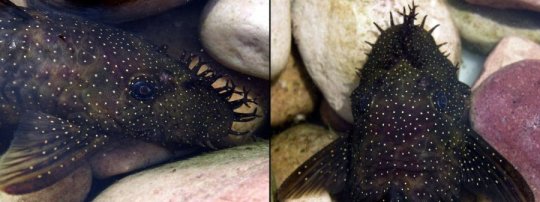[ad_1]
No one knows just how many species live in the Amazon rainforest — scientists estimate that it’s home to one-third of the world’s animal and plant species. There are still thousands out there waiting to be discovered — like these six new catfish with faces covered in tentacles.
“We discovered six new species of really cool catfish from the Amazon and Orinoco River basins. They have tentacles on their snouts, they have spines that stick out from their heads, almost like claws, to protect themselves and their nests, and their body is covered with bony plates like armor,” says Lesley de Souza, a conservation scientist and ichthyologist at Chicago’s Field Museum and lead author of a paper in Zootaxa describing the new species. “They’re warriors, they’re fish superheroes.”
The new catfish are all members of the genus Ancistrus, also known as bristlenose catfish. If you’ve ever had an aquarium, you might know them as the sucker-mouthed “algae-eaters” that help keep tanks clean. These river-dwelling fish are between three and six inches long, and the males have tentacles erupting from their snouts. They’re there to persuade females that their owners would make good dads. Ancistrus catfish fathers look after their young, guarding nests of eggs and warding off predators. And the tentacles make potential fish dads look like they know what they’re doing. “The idea is that when a female fish sees a male with these tentacles, to her, they look like eggs. That signifies to her that he’s a good father who’s able to produce offspring and protect them,” says de Souza. It’s an evolutionary move that takes “catfishing” to a whole new, kind of sweet level.
Some of the new species’ names hint at the animals’ traits or the story of their discovery. For instance, Ancistrus patronus’s name means “protector,” a reference to how Ancistrus fathers care for their young. The species-defining “type specimen” for A. yutajae is named for two star-crossed lovers in an Indigenous Amazonian legend; it was discovered on Valentine’s Day in 1981. Some of the other new species’ names have a personal connection for de Souza — A. kellerae for Connie Keller, a major supporter of conservation science at the Field Museum, A. leoni after a deceased colleague, A. saudades for the Portuguese word for melancholy, for de Souza’s nostalgia for her Brazilian homeland.
The catfish are found in northeastern South America, in an area of Venezuela, Colombia, and Guyana known as the Guiana Shield. The fish live in clear, fast-moving rivers and streams. “If you’re in the right habitat, you’re going to find a lot of them,” says de Souza, who co-authored the Zootaxa paper with her former PhD advisor Jonathan Armbruster of the Auburn University Museum of Natural History, a leading expert in South American sucker-mouth catfishes, and long-time colleague and mentor Donald Taphorn, also an Neotropical ichthyologist. “But they are sensitive to subtle changes in the environment, we have seen this at sites where they were plentiful and now scarce, this is due to habitat destruction.”
Threats to the fishes’ habitat include large-scale agriculture, deforestation and gold mining. “Miners dredge up the river bottom causing increased sediment load, this changes the habitat structure of the river system, thus impacting the fishes ability to survive,” says de Souza. “Another effect from gold mining is the use of mercury to extract the gold in the river. This impacts all wildlife and principally local people that consume these fishes and other species in the watershed.”
And problems affecting the catfish don’t stop with the tentacle-faced Romeos. “The whole ecosystem is interconnected — you can’t separate the species in it. Giant river otters love to eat these catfish, and jaguars have been observed to have higher mercury levels from eating contaminated fish or other species that feed on fish. This can have dire impacts on the whole ecosystem,” says de Souza. “All the layers of the Amazon basin are interconnected from the rivers to the forest canopy.”
According to de Souza, the process of saving the Amazon starts with things like discovering new species and putting names on them. “Everything begins with naming a species and determining how many species you have. Once you have done the taxonomy then you can study the ecology, behavior, and do conservation action,” says de Souza. “For example, Ancistrus kellerae, is a species only known from the highlands in Guyana. There are current threats to its ecosystem by gold mining, but now that is has a name we can try to push for conservation protection of the area with this endemic fish species.
The importance of these catfish to the bigger picture of Amazonian conservation inspired de Souza to name one of the new species after Connie Keller, the former chair of the Field Museum’s Board of Trustees. “When I met Connie, I was immediately inspired by her contributions to our Science Action Center,” says de Souza. “It might just be that the fish I named after her could help us protect this river system. Even as a fish, she’d be supporting conservation.”
With untold unknown species remaining in the Amazon, the work is far from over. “I have this undying curiosity — what’s around that bend, that corner, what’s in that creek, what can I find? And this project was all about discovery, whether we were finding new species in rivers in Guyana or in jars in museum collections. This study included more than 500 specimens, but this is just a drop in the bucket — there’s still so much more to learn about Ancistrus and other Neotropical fish.”
[ad_2]















